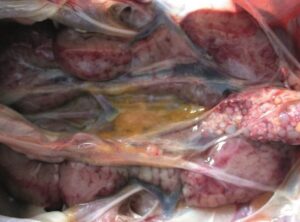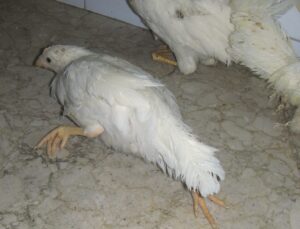Poultry Business held a virtual round table discussion, sponsored by Boehringer Ingelheim. Marek’s disease and its prevalence and prevention was the topic, and PB editor Chloe Ryan was joined by a panel of experts to discuss the challenges and opportunities in different parts of the supply chain
The panel clockwise from top left
ALEXANDRA MCDANIEL Avian veterinary advisor at Boehringer Ingelheim
KEITH WARNER Head of poultry health and welfare and agricultural assurance at Avara Foods
RICHARD JACKSON Clinical director St David’s poultry team and president of the BVPA
MIKE CLARK Avian veterinary advisor at Boehringer Ingelheim, clinical associate professor in poultry medicine & agribusiness at Nottingham Vet School and junior vice president of the BVPA
JOHN HODGKINSON Production director for Lohmann GB, representing 20 farms within the company that produce layer parents and broiler breeders

Marek’s Disease (MD) is a highly contagious endemic viral disease that is prevalent in the environment and affects poultry with symptoms including increased mortality, paralysis, and organ and skin tumours. For a long time, it has been controlled through vaccination, but over the years the virus has become more virulent.
Different parts of the poultry sector are affected to different degrees, with longer lived birds such as breeders and commercial layers more seriously impacted by an outbreak. Standard broilers do not generally live long enough to show overt clinical signs, although infected broiler flocks can show signs of immunosuppression and sometimes signs are discovered in broilers at the abattoir, when 5-10% of an affected flock can be rejected by the processor.
One of the complicating factors in controlling MD is that it is not always easy to secure a definitive diagnosis. But amid the uncertainties, there is agreement that the disease has evolved to become more virulent.
ARMS RACE
“There has been a bit of an arms race between vaccine control and keeping signs of clinical disease at bay,” says Mike Clark, avian veterinary advisor at Boehringer Ingelheim. “Over the years the field virus has altered and has become more virulent. “What we do in the way of control – not just vaccination – has got better and better, but we have seen an escalation in virulence of the virus.”
Richard Jackson, clinical director of St David’s poultry team, says he had experienced a small increase in MD prevalence among organic and free-range broiler flocks. But he says it is not certain whether this is a reflection of a general increase in the disease or whether it was linked to growth in that part of the market, and therefore the number of flocks on the ground.
“One of the problems for farmers is when you have got MD in broiler birds you can’t really see clinical signs on the farm, so the birds look totally fine and then the farmer gets back a bit of paper from the abattoir saying there has been 5-10% condemnation,” says Jackson.
“Outbreaks are usually quite sporadic, so it is difficult to gauge the prevalence of the disease itself,” says Alex McDaniel, veterinary advisor at Boehringer Ingelheim. “Certainly, from our experience, there seems to be an increase.” Some areas of the country are more badly affected than others.
“My own experience is there is a geographical predisposition,” says Jackson. “For one of the sets of cases I’ve been involved in, there was a lot of poultry in the area in extensive systems. The flipside is on the layer side; you can have a farm completely isolated with no poultry around it and bizarrely, they have got MD. It does tend to baffle you. “My thoughts are the virus is probably quite prevalent across the UK at low levels but it is where this viral load is in conjunction with a combination of stresses that the disease occurs. It is probably more widespread than we think.”
IMMUNOSUPPRESSION
One of the main difficulties associated with MD is diagnosis, because birds often present as immunocompromised initially, and MD may not be the obvious cause. “Clinical MD is really the tip of the iceberg,” says Keith Warner, head of poultry health and welfare and agricultural assurance at Avara Foods.
“If we have broiler breeders with clinical MD, we can pick that up relatively easily; it is an infrequent event, but it does happen within the industry.
“The bit that we really want to know is how much of it exists in a sub-clinical fashion that has an impact. We see evidence on broiler farms where it would appear the birds are immunosuppressed. The reason for that immunosuppression is poorly understood but MD is one of the potentials. If you grow birds to an older age, you often pick things up in abattoirs, so you might start seeing tumours in skin, and you may see numbers of paralysed birds on farm.
The panel discussed what came to mind when thinking of an immunocompromised bird. Generally, birds that are immunocompromised will be more susceptible to other pathogens, such as coccidiosis, so you may see higher levels of coccidial lesions.

“The classic diseases that would lead to immunosuppression across a flock would be Gumboro disease or infectious bursal disease (IBD), MD and chicken anaemia virus. They are the three classics,” says Warner. “I have dealt with cases in the past where we were aware of MD in broilers and you have some really severe immunosuppression. These diseases can act alone or they can act in combination. Other impacts from immunosuppression may be higher levels of lameness and rejects in the factory.
“Whenever birds go through the factory, there is a small proportion carrying a bacterial load that makes them unfit for human consumption. “And you might see that inexplicably rise in the case of the birds being immunocompromised,” Warner adds.
VACCINATION
What is clear is that vaccination programmes against MD have been hugely effective since they became routine. John Hodgkinson, production director for Lohmann GB, says along with better quality housing, Marek’s disease vaccines have had a massive impact on preventing the devastating effects the industry experienced before the use of effective MD vaccines. “I represent the 170,000 layer parents we put down per year and the 28,000 birds we have on the rearing farms. And we are not seeing any signs or conditions connected with Marek’s at all.
“All of our layer parents are now in new build facilities and that offers a great opportunity for good biosecurity and optimal cleaning and disinfection at turnaround. The breeder team have done a cracking job; the quality of the day olds coming to the farms, and therefore the health status of the chicken, are already in a good place and these are positives.
“From the breeder perspective, the day old mortality now has dropped dramatically. We are rearing through 0-16 weeks with 1% mortality. It is a phenomenal change in the health status of the birds coming into the farms where we were seeing 3-4% mortality in the first week. With any vaccination programme, if the chicks you have coming in are poor quality, it is always going to have that knock-on effect on health status going through the flock.”
LISTLESS BIRDS
Hodgkinson has, however, experienced MD, and describes his experience of an outbreak among broiler breeder rearing birds several years ago. He says the birds were around five to six weeks of age. “We started seeing some changes in feed refusal; they weren’t necessarily eating their food. Then we saw a rise in a few culls, we saw a few birds that were a bit listless, not happy. Then there was one bird we saw with the classical signs of bilateral wing and leg paralysis, and we then thought we’re dealing with something different.

“We reverted straight to the veterinary team to send some post-mortems,” he adds. “Then over the next few days, there were a few more visits by the vets to diagnose that yes, we were dealing with MD. Then there were more culls for paralysis and they were generally not happy with life. It was a strange disease to manage and monitor, but the majority of the birds went on to do OK.”
Jackson says he would start to suspect MD in a flock of broiler breeders or layers if there were higher than expected levels of mortality and antibiotics given for bacterial peritonitis had failed to make much impact. “On a broiler setting, just a chronic poor performance, an increase in rejects and an increase in leg culls and probably an increased in coccidiosis. With slower growing breeds, it will be rejects and seeing the odd bird with paralysis.”
Diagnosis would be made based on post-mortems looking for tumours in organs such as the liver and spleen. In an abattoir you can look for the skin tumours in MD but they will only be obvious once the bird has been plucked.
VACCINATION
The panel discussed common vaccination programmes for different types of birds. Most often high value birds such as broiler breeders, layer breeders, and commercial layers are vaccinated in the hatchery, either at a day old or in-ovo, whereas broilers are not generally vaccinated for Marek’s disease.
Jackson said there tended to be different vaccine regimes, which vary depending on the type of bird and localised disease challenges, such as ILT. During outbreaks, there can be “a bit of tension,” says Jackson, “between whoever reared the birds, and who vaccinated them. “Are we questioning vaccination techniques? Are we questioning viral challenge on the farm? Are we questioning hygiene and management on the farm?
“The current offering does give reasonable protection, but we need to be ever vigilant because we do know from the history of MD that the virus does evolve in terms of virulence so it is a bit of an arms race, so we need to keep ahead,” adds Jackson.
“When we do get Marek’s cases, we need to understand why. Has the virus out-competed the vaccine? Is it a vaccination failure or is it a management failure, or is it a failure of hygiene that has led to a high infectious pressure?”
“It is important there is monitoring about the new strains around and the virulence of those strains and whether the vaccines are effective,” says Warner. “That is challenging for everybody. If we and the vaccine companies don’t know the prevalence, they can’t react to help us with that.”
Boehringer Ingelheim has recently launched a new vaccine, Prevexxion, which is a hybrid vaccine that contains parts of the genome of three different type of serotype 1 MD vaccine. Unlike other vaccines it protects against very virulent MD.
“It is new and different because it has three different components from three different MD strains,” says McDaniel. “It is also the only MD vaccine licensed against very virulent MD viruses as well, so that is a very exciting development.”
Boehringer Ingelheim is now introducing the new vaccine to the UK poultry industry. “We like to get out and meet vets in practice and poultry companies,” says Clark. “In the first instance what we decided to do with Prevexxion is speak to vets who prescribe vaccines in hatcheries to make sure they understand it. There is a temptation, because people are familiar with Rispens vaccines, to think ‘oh, it’s just another Rispens vaccine’. But it is a novel vaccine, because it is a hybrid of 3 different serotype1 MD strains, it is effective at providing protection against very virulent MD in a way that also safeguards bird health, due to the novel method of attenuation. It is about getting across how it has been achieved with the latest vaccine technologies and making sure the vets are aware of this development.
“We didn’t want to go to people in the poultry companies and for them to catch their prescribing vet off guard. We are now speaking to people in poultry companies to make sure they know where Prevexxion sits and how applicable it is to their business.”
Jackson thinks some of the first people to adopt the new vaccine will be commercial layer farmers that have had MD issues in the past. “It is about balancing cost and potential risks and, ultimately, if you’ve had a couple of flocks with MD, you’ve got nothing to lose and farmers need and want to try new options,” he adds.
“Undoubtedly another vaccine coming out with increased protection is a good thing. I think we’ve all got to be careful we don’t use it as an excuse on any farm for letting down the guard on hygiene and biosecurity,” says Jackson.
“I think in the distant past when the Rispens vaccine was introduced to the UK, there was the concern then that it didn’t encourage farmers to do as much for biosecurity. So, if we are trying to counter the increase in virulence then a new vaccine is the way forward, but we need to make sure we don’t take our eye of the ball when it comes to biosecurity.”
REMOTE AUDITS
New technology is now also being employed in hatcheries where vaccines are administered, in order to provide assurances for the whole supply chain. Aviagen’s broiler breeders are now being vaccinated in-ovo, Hodgkinson says. “They now do videos of the process, the vaccination room is videoed, the fridge, temperatures, people mixing the vaccines, the vaccine being administered to the eggs, so there is due diligence.”
Clark adds: “The industry is very transparent but in a hatchery, you don’t want an army of people marching through compromising biosecurity. That has always been the dilemma when it comes to auditing vaccination in a hatchery. The introduction of ‘virtual’ audits, where there have been stringent biosecurity or COVID-related restrictions, has added an extra dimension of flexibility to audits. Of course, face to face hatchery audits are by far our preference, but remote audits have their place in certain circumstances.”
CLEANING & DISINFECTION
Thorough cleaning and disinfection is always important in any poultry operation, but if there has been MD, it’s important to be even more thorough than usual. MD is predominantly in the feather follicle matter contained in dust left over in sheds, so it stays in the dust rather than the faeces like many other diseases.
High quality new poultry housing is far easier to clean and disinfect thoroughly. “We all clean our sheds, but it is about how well you clean them and how much do you get rid of every particle of dust,” says Warner. “When you look at the furniture, there are so many areas that are difficult to get to, so it is about getting to the nooks and crannies and different surfaces.”
“One of the things I would encourage farmers to think about are high up surfaces, fan shafts, ventilation inlets, and washing the outside of the shed,” says Jackson. “It is also worth mentioning the more extensive systems don’t tend to be standardised designs and some of them have got very bizarre air spaces like little lofts, with lots of dust. I think I would encourage anyone who has had MD to get a hygiene audit from one of the disinfection companies, a lot of them do it either free or very heavily discounted. Multi-age sites are a huge risk factor for MD; it’s one thing doing a fantastic clean out or your rearing shed or your broiler shed but if you have birds next door and they are hauling muck past your birds it doesn’t always lend itself to good biosecurity.”
Keeping other areas of the farm clean is also crucial. “There is a lot of focus on cleaning where the birds are but other areas get less attention,” says Warner. “There might be good reason for that if they are full of computers, if you haven’t got those areas clean and free of dust then you can clean inside the shed as much as you like but you are taking that dust inside. The same goes for break rooms and toilets. That dust can end up anywhere on the farm.”
GREATER PROTECTION
Hodgkinson said that as commercial layers continue to push for longer lived birds, it’s more important than ever to implement better biosecurity, better modern housing and a good vaccine programme in order to keep diseases at bay. Biosecurity is crucial, says Warner. The higher the background disease challenge, the “more chance you have of that breaking through the vaccine. The application of the vaccine is hugely important as well as what the vaccine is, to ensure you get consistent coverage.”

Chloe Ryan
Editor of Poultry Business, Chloe has spent the past decade writing about the food industry from farming, through manufacturing, retail and foodservice. When not working, dog walking and reading biographies are her favourite hobbies.

